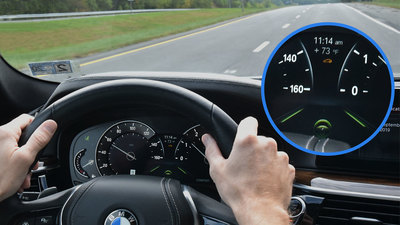Automated Driver Systems Update
Lane-centering problems may limit drivers' acceptance of automated systems
Arlington Va. October 3, 2019; Road warriors may wish for automated technologies that take the stress and boredom out of the daily commute. But current systems designed to keep vehicles from drifting over the center line or onto the shoulder still don't all work well enough to inspire trust, according to a new study from the Insurance Institute for Highway Safety.
Based on the results of brief test drives by 20 of their co-workers, IIHS researchers found that most drivers were relatively confident in the performance of adaptive cruise control systems, which function like traditional cruise control but also adjust the vehicle's speed to maintain a minimum following distance from the vehicle ahead. However, testers had less faith in lane-centering systems, which provide sustained steering control to keep the vehicle in its lane, and that colored their overall impressions of the vehicle's automation.
"Across all the vehicles we tested, the drivers had more faith in the automated systems' ability to maintain a steady speed and a safe distance from the vehicle ahead of them than their ability to keep them safely in the center of their lane," says IIHS Senior Research Scientist Ian Reagan, the lead author of the paper. "But how well they perceived the lane-centering technology to work had a bigger impact on how they rated the overall experience."
That's important because past research has shown that collision-avoidance systems can eliminate or mitigate many crashes — most of which are the result of driver error. Systems that automate certain driving tasks might go further, preventing risky situations from developing in the first place by increasing following distance, for example. But for assistive technologies to make driving safer, drivers have to accept them and use them correctly.
To learn more about the connection between acceptance of automated systems and driver perceptions of how well the technologies function, IIHS researchers analyzed test drives conducted by 20 IIHS-HLDI employees in five vehicles: a 2017 Mercedes-Benz E300 sedan, a 2019 Infiniti QX50 SUV, a 2018 Volvo S90 sedan, a 2017 BMW 530i sedan and a 2016 Tesla Model S sedan. All five were equipped with adaptive cruise control and lane-centering.
Each volunteer drove the vehicles just once over one of two varied routes near the Institute's offices in Virginia. One location, Arlington, is more urban. The other, Ruckersville, is rural. For the study, the drivers also used the systems on portions of the routes that included off-ramps, intersections and other road features that manufacturer disclaimers warned they might not be able to handle.
The results confirmed findings from a similar 2018 study that showed people feel more comfortable with systems that make smooth, gradual speed or steering adjustments, as well as an earlier one that found drivers had greater faith in adaptive cruise control than active lane-centering systems (See "Drivers prefer automated systems that operate smoothly," February 14, 2018 and "IIHS-HLDI test drives uncover driver assistance system quirks," November 10, 2016).
Across all vehicles, more than three-quarters of participants agreed that the automated systems accelerated and decelerated the vehicle smoothly and detected moving vehicles ahead. But fewer than half agreed that the technologies consistently detected lane markings on the roadway, detected stopped vehicles ahead, or that they knew whether the automation detected lane markings on the roadway. And those factors played a more important role in their general perception of how well the system performed.
"Better performance in detecting lane lines, detecting vehicles ahead and making smooth, gentle steering corrections translated into stronger agreement that the automation improved the overall driving experience," Reagan says.
On average, drivers were mostly neutral about whether automation improved the overall driving experience. That's partly because they didn't feel that the systems drove like they do when they're in control.
"I didn't like how this computer could just randomly decide to correct my driving when there was nothing wrong with where I had the car," one driver said. "When they would correct my driving, I felt kind of insulted by the car."
Quirks or system failures might also have been a factor. Various drivers complained that the automation steered them toward obstacles or seemed to fight back against their efforts to steer the vehicle back on course.
"We got onto a smaller, two-lane country road that had some dips and curves," another driver recalled. "I remember going through a right-hand curve and feeling like the BMW was steering me too far over the center line. The Tesla, through the same sorts of curves, felt like it was bringing me too close to the guardrail on the right side of the car."
As might be expected, such problems were about twice as common on state highways and secondary roads, where the road features are less uniform, than on interstate highways. Moreover, many of them were connected with road features that owner manuals warn against relying on automation to navigate, such as hills and intersections. But because those manuals are long and complicated, people don't always read them. When they do the information is not always clear. Some use the more ambiguous term "highways" to denote limited-access, divided freeways, for example.
"As carmakers improve this technology, features that ensure that people can only use it where it's designed to work will be vital to safety and will also make drivers more confident in the automation," Reagan says.



